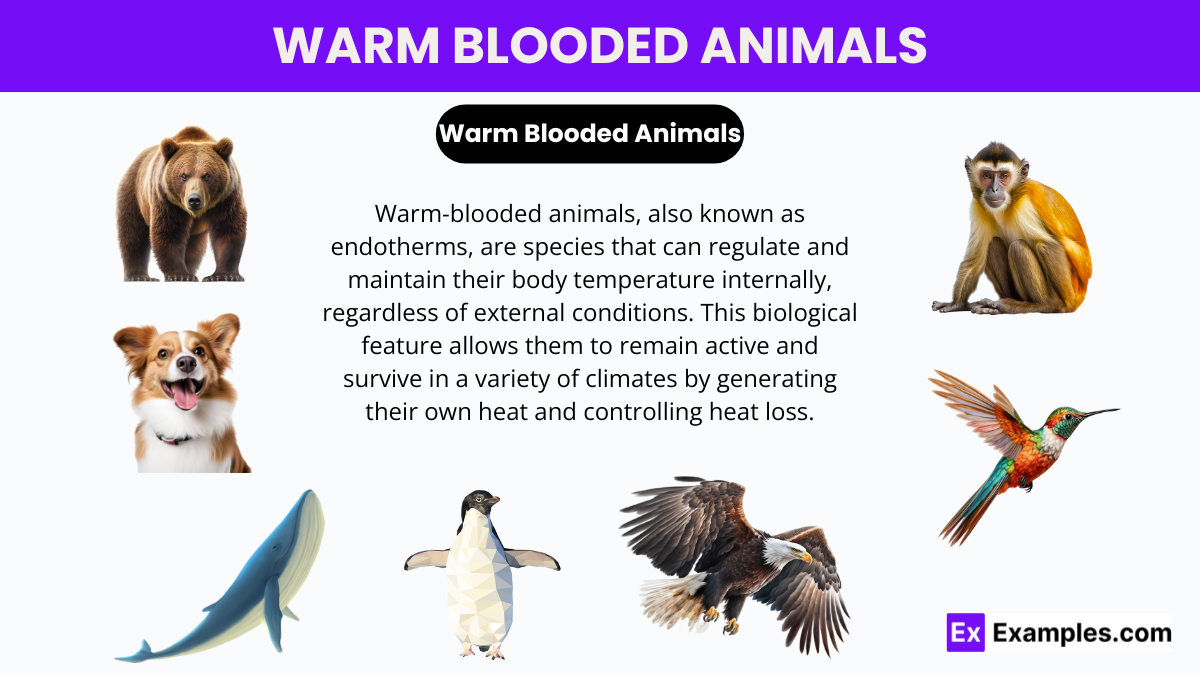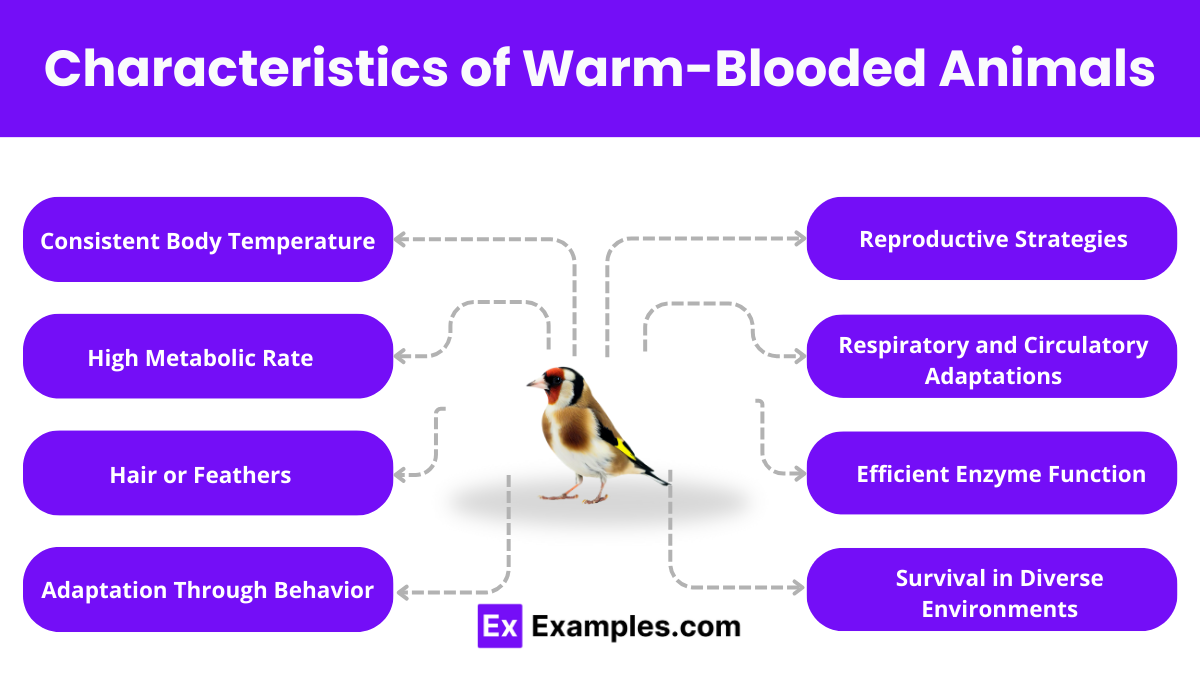Which of the following is a characteristic of warm-blooded animals?
Their body temperature fluctuates with the environment
They can regulate their body temperature internally
They only live in warm climates
They do not have fur or feathers


Warm-blooded animals, primarily birds and mammals, maintain a body temperature higher than their surroundings through internal processes like shivering or metabolic changes. This adaptation allows them to thrive across diverse environments but requires more energy, making them vulnerable during food shortages. Although terms like warm-blooded and cold-blooded are common, scientists prefer more precise terms such as endothermy and ectothermy to describe these thermoregulation mechanisms.
Warm-blooded animals, or endotherms, are species that regulate their body temperature independently of the environment. This group primarily includes mammals and birds. These animals generate their own heat through metabolic processes, which allows them to maintain a constant body temperature regardless of external conditions. Key characteristics of warm-blooded animals include consistent internal temperatures, higher food requirements due to continuous heat production, and physiological adaptations such as sweating or panting to manage their temperature.

The most defining feature of warm-blooded animals is their ability to keep their body temperature constant. This is achieved through internal heat production and various physiological mechanisms such as sweating, shivering, and altering blood flow. Maintaining a stable temperature allows these animals to thrive in a variety of climates, from the icy Arctic to the sweltering tropics.
Warm-blooded animals have high metabolic rates, which means they burn a lot of calories to produce heat and maintain body temperature. This high metabolism requires frequent intake of food to supply the necessary energy. As a result, these animals are often more active in seeking food and more complex in their behavior compared to cold-blooded animals.
Most warm-blooded animals are covered with insulation in the form of fur or feathers. This layer helps to retain body heat. Mammals have fur, while birds are covered with feathers. The density and type of covering can vary depending on the environmental conditions, providing further adaptation to different temperatures.
Behavioral adaptations are also significant among warm-blooded animals. For example, birds migrate to warmer regions during winter to avoid the cold, while some mammals hibernate to conserve energy during times when food is scarce.
Warm-blooded animals tend to have more complex reproductive strategies compared to cold-blooded animals. They often invest more energy into fewer offspring, providing extensive care until the young are capable of regulating their own body temperature and surviving independently.
These animals have advanced respiratory and circulatory systems that efficiently manage oxygen and distribute heat throughout the body. Mammals have diaphragm-controlled lungs that allow for efficient air exchange, and birds have a unique air sac system that provides constant fresh air through their lungs for high oxygen needs.
The enzymes in warm-blooded animals are adapted to function optimally at their stable internal temperatures. This efficiency allows for rapid muscle responses and sustained activity, enabling complex behaviors such as flying, running, and swimming.
The ability to regulate their own body temperatures enables warm-blooded animals to inhabit diverse environments. This thermal independence contributes to their survival in various ecological niches and their ability to adapt to changing climates.
Endothermy allows animals to maintain activity in cold conditions, enabling them to hunt or escape predators when cold-blooded competitors might be immobilized by low temperatures. The ability to inhabit diverse environments and maintain consistent physiological functions regardless of external temperatures offers significant survival advantages.
The major disadvantage of being warm-blooded is the high energy requirement. Warm-blooded animals need to consume a lot of food to fuel their constant heat production. This demand can make survival challenging during times of food scarcity. Moreover, maintaining a constant body temperature requires complex physiological mechanisms, which can be susceptible to malfunctions and diseases.
Warm-blooded animals regulate their body temperature internally, maintaining consistent warmth regardless of environmental changes.
Cold-blooded animals depend on external heat sources for warmth, while warm-blooded animals generate heat internally to maintain body temperature.
Birds are the primary warm-blooded animals that are not mammals, capable of regulating their internal body temperatures.
Some water animals, like whales, dolphins, and seals, are warm-blooded, maintaining a constant body temperature in cold waters.
Jellyfish are cold-blooded, relying on the temperature of their aquatic environments to regulate their body heat.
Text prompt
Add Tone
10 Examples of Public speaking
20 Examples of Gas lighting
Which of the following is a characteristic of warm-blooded animals?
Their body temperature fluctuates with the environment
They can regulate their body temperature internally
They only live in warm climates
They do not have fur or feathers
Which of the following animals is warm-blooded?
Frog
Shark
Sparrow
Lizard
Why is being warm-blooded advantageous for some animals?
It allows them to survive in extreme temperatures.
It makes them immune to diseases.
It means they do not need food.
It requires less energy.
Which group of animals are all warm-blooded?
Fish and reptiles
Amphibians and insects
Birds and mammals
Mollusks and crustaceans
How do warm-blooded animals generate heat?
Through external heat sources
By converting food into energy
By basking in the sun
Through hibernation
Which of the following is an example of a warm-blooded mammal?
Crocodile
Tuna
Dolphin
Salamander
What term is used to describe warm-blooded animals?
Ectotherms
Endotherms
Poikilotherms
Exotherms
How do warm-blooded animals maintain their body temperature in cold environments?
By increasing their physical activity
By hibernating for long periods
By using external heat sources
By slowing their metabolism
Which of the following adaptations helps birds maintain their body heat?
Scales
Feathers
Gills
Smooth skin
Which warm-blooded animal is known for its ability to fly long distances without losing body heat?
Penguin
Bat
Whale
Elephant
Before you leave, take our quick quiz to enhance your learning!

